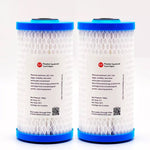You have no items in your shopping cart.
If you're shopping for a water filter for your house, it almost always includes activated charcoal. To make the best out of your water cooler, you need to find the best activated charcoal water filter for water coolers.
Carbon filters, also known as activated carbon or carbon block filters, capture impurities through a process known as adsorption. It enables only smaller water particles to pass through their media.
They're one of the most effective water filtration methods. We use it in anything from portable water pitcher filters to whole-house filters and countertop systems.
HOW IT'S MADE
Carbon filters often consist of raw materials such as coal (also known as activated charcoal filters) or coconut shell. These materials have a high carbon content naturally, so some use them to manufacture carbon filters. The quality of the material utilized and the material itself will significantly impact the filtering quality.
For numerous reasons, coconut shell carbon is rapidly becoming a more popular choice of material for carbon filters:
- To begin with, they're a renewable resource, making them a green alternative.
- Second, carbon charcoal filters contain a far higher percentage of micro-pores on their surface.
Coconut shell carbon is a more effective filtration solution for improving water quality. It has more micropores across the same surface, allowing it to trap a wider range of pollutants.
Activated carbon filters are extremely porous, allowing them to adsorb (remove) pollutants from the water as efficiently as possible. Some activated carbon filters will allow larger particles to pass through, while others will trap them.
WHY AN ACTIVATED CHARCOAL WATER FILTER IS A GREAT ADDITION TO YOUR WATER COOLER
Activated carbon filters can remove a wide range of undesired and hazardous substances from your water, potentially putting your health at risk. Pesticides and herbicides, volatile organic compounds like benzene, chlorine, and its hazardous derivative, trihalomethane, are among the toxins that activated carbon filters remove from water. You can find these filters to remove at least 81 pollutants completely and effectively lower the presence of another 52.
According to the Environmental Protection Agency, activated carbon filters are the only water filtration devices that guarantee the removal of all 14 pesticides and 12 herbicides, and all 32 recognized organic pollutants. Activated carbon filters also eliminate chlorine that may have escaped the treatment phase and ended up in your water.
Chlorine can give your water a bad taste and odor, but it can also lead to the development of trihalomethane. A chemical reaction between chlorine and natural organic materials in water produces trihalomethane. Trihalomethane, in high amounts, can harm reproductive health and potentially cause cancer. You can remove chlorine from your drinking water and lower your risk of trihalomethane exposure by utilizing an activated carbon filter.
CHOOSING THE BEST ACTIVATED CHARCOAL WATER FILTER FOR WATER COOLERS

Ensure that the Activated Carbon comes from coconut.
The fundamental reason for this is that coconut-based activated carbon possesses micropores similar to pollutant molecules in water. As a result, it's quite good at trapping these pollutants. The pore size of coal and wood-based activated carbon is substantially larger. As a result, they do not purify water as efficiently.
Externally Examine The Activated Charcoal
Look for cracks, which appear as tiny lines in the illustration. Also, keep an eye out for a buildup of carbon dust outside the filter. Filters of good grade do not release a lot of dust. Expect a small amount of carbon dust.
You should also check that the block isn't too fragile. As for any paperwork related to stress tests,
Examine the certification for quality assurance.
The market swamps with blocks of poor quality and performance may appear attractive on the surface. But it falls short in terms of performance and longevity.
One method to be certain is to check for reputable quality certifications such as NSF, ANSI, and WQA. These certificates are generally a reliable way to distinguish quality products from others, as they're given after regular quality inspections and extensive product testing.
IMPORTANT PROPERTIES OF ACTIVATED CHARCOAL
Activated carbon has various features and characteristics. Studying them will help you understand how the material is tested and examined.
Pore Diameter
The size of the pores on and inside activated carbon will have a big impact on how well the material works. Pore diameter can influence a carbon's specific application since activated carbon with more micropores (smaller holes) can successfully remove low organic matter levels from water. Activated carbon with small and large pores is versatile since you can use it to remove chlorine and a wide range of organic materials simultaneously.
Iodine Number
The measurement of the efficacy of activated carbon uses iodine adsorption. You can add activated carbon to a liquid containing a precise amount of iodine during this test. Manufacturers vigorously stir the carbon until it has completely dissolved in the solution. After a few minutes, it filters the solution into another container to remove the charcoal particles. It allows the liquid to pass through. The iodine number indicates how much it can extract iodine from the fluid. In other words, the higher the number, it took out more iodine.
Density
The volume activity is influenced by density. A higher density indicates a higher-quality activated carbon in general. Real density, which is the density of the material excluding the voids, and particle density, which is the observed density of the carbon particles alone, are two approaches to determine density. Wetted density, apparent density, bed or bulk density, and tamped density are all examples of density. All of these density measures provide detailed information on the performance of activated carbon.
Surface Area
Another essential attribute frequently mentioned of activated carbon is its surface area. The surface area of charcoal varies depending on the source material, the activation method, and other factors, giving it greater or less adsorption potential. It commonly uses a BET nitrogen adsorption test to determine the surface area of activated carbon.
Mesh
It uses a mesh system to measure the size of granular activated carbon (activated carbon in the form of a powder or fine grains). A sample of granulated carbon is shaken through a series of fine sieves to determine it. Imagine sieves that are considerably finer than a window screen, with many tiny pores between the wires. It can assess the activated carbon for general size using a technique that measures how much carbon passes through the filters.
Ash Content
The ash content of activated carbon is an important metric that can significantly impact the product's performance and use. Ash in activated carbon reduces the speed and reliability of reactivation, and metal oxides can be released from charcoal with high ash content, resulting in discoloration when used to purify water. Metal oxides can be removed from charcoal with high ash content, resulting in discoloration when purifying water. Fish tanks should avoid carbon with a high ash concentration since it can cause heavy metal poisoning in aquatic life, including fish and coral species. The type of ash might also differ. For example, activated carbon derived from coconut shells typically contains a higher proportion of alkali earth metals than coal, which typically contains heavy metals.
FINAL THOUGHTS: Best Activated Charcoal Water Filter for Water Coolers
To make the best out of your water cooler, you need to find the best activated charcoal water filter for water coolers. Activated carbon is carbon-based material, such as coconut or peat, that has been 'activated' by heating it to high temperatures in a specific kiln. As a result, it develops an extraordinarily intricate network of pores, greatly increasing its surface area.












